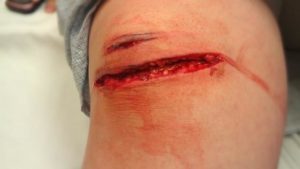A wound is defined as a tear in the skin tissue, or, more exactly ‘a breach in skin integrity’. It can be divided into 2 types:
- Wounds due to surgery (incised wound)
- Wounds due to loss of skin tissue
Wound healing

Pic source: thinglink.com
The healing process goes through a number of steps, depending on the type of wound. The incised wound i.e. the wound after surgery and stitching will heal by the process of first intention.
First intention happens when the edge of the wound is closely stitched. The presence of platelets (blood cells that help in coagulation) and proteins known as fibrin will make sure a blood clot forms in the stitched wound and further attaches the edges of the wound. Next, blood capillaries will grow followed by the presence of fibroblast cells. The fibroblast cells will ensure the growth and formation of new tissue and closure of the wound in the period of 10 to 14 days. Wounds in the facial area will heal in a shorter period between 5 to 7 days.
For larger wounds with loss of skin tissue, the healing process will occur by secondary intention. These type of wounds can be a result of accidents and diabetes, or wounds that have been infected.
Healing will start with ‘cleaning’ by phagocytic cells (blood cells which swallow germs and foreign bodies). This is followed by formation of granulation tissue (early stage scarring, pink in colour) at the bottom of the wound. Because the wound is large, it requires myofibroblast cells which shrink the wound (wound contraction) while forming epithelium tissues (cells on the skin surface) from the wound edges until the whole of the wound recovers.
Period of Healing
What influences the process of wound healing? The wound healing process is influenced by many factors and can be divided into systemic and local factors.
Systemic factors
- Age
- Diabetes Mellitus
- Peripheral Vascular Disease (Blood Vessel diseases)
- Immunodefiency (Chronic illness or AIDS)
- Malnutrition
- Lack of protein (albumin) in the body
- Smoking
- Cancer
- Some medications like steroids, immunosuppressives (medicines which suppresses the bodily defense system) and cytotoxic agents (medicine which kills living cells)
In general, wounds in children will heal faster than in adults. Diabetes and small blood vessels due to peripheral blood diseases will slow the healing process due to lack of oxygen and nutrient supply to the wound area. Smoking will affect in the same manner because smoking leads to contracted blood vessels. Albumin is an essential protein because it acts as a carrier for nutrients. The normal reading for Albumin in our body is over 30g/dL.
Local factors
- Bacterial infection
- Decreased blood flow to the wound area
- Excessive movements if the wound is located around joints
- Foreign body in wound
Bacterial Infection
There are a few signs visible when an infection happens. The patient will usually catch a fever. The wound will turn red, warm and produce pus or plentiful exudates. The exudate fluid is a whitish or yellowish fluid coming out from the blood vessels due to inflammation or bacterial infection. The white blood cell count will increase more than 15,000/mm3.
How to speed up the wound recovery?
A good blood supply and absence of infection will determine the length of the healing process apart from the size of the wound. Certainly a larger wound will take longer to heal.
Blood supply is important because it delivers oxygen and nutrients which is much needed in the healing process. It is measured by seeing Transcutaneous Oxygen Tension being over 30mmHg and Ischaemic Index over 0.45.
Do follow the steps below to ensure your wounds heal quickly:
- Make sure you take nutrition and balanced food. Consume high protein foods such as chicken, eggs and fish.
- Eat more green vegetables because they are rich in minerals such as zinc which is very much needed in wound healing
- Be mindful of your wound cleanliness. Clean and change the dressing according to your doctor’s or nurse’s advice.
- Stop smoking.
Wound scar problems
Two problems can typically happen:
- Hypertrophic scar
- Keloid
Hypertrophic scar is a condition which the scar can turn wide and elevated. It does not spread outside of the original wound edge. For this condition, it can subside and heal itself in a period of 18 months.
A more severe condition is if a keloid forms. Keloid is excessive scar tissue which grows extending the actual wound edge. This is an ongoing process and does not stop. It is caused by excessive production of fibroblast cells and collagen.
Should I practice post wound abstinence (pantang)?
NO, you DON’T have to!
If you keep away from various kinds of food especially from eggs and chicken, it will slow down the healing process because you will be deprived of protein. This is due to the protein deficiency leading to a low amount of albumin in your blood. As said earlier, albumin is a transport protein which carries nutrients to the wound area. Lack of nutrients will retard the healing process.
You only have to practice abstinence if you are allergic to those kinds of foods.
If you experience other problems like slow-healing wounds, germ infections in the wound or keloid scars, do see your nearest doctor in a timely manner for further treatment.
Dr. Ahmad Mahyuddin is an orthopaedic surgeon in Pahang. He is also an advisor for The Malaysian Medical Gazette. Get to know him more in The Team page.This article was translated from https://www.mmgazette.com/luka-dan-proses-penyembuhan-dr-ahmad-mahyuddin/ by Azizul Ismie Mohd Puad.
[This article belongs to The Malaysian Medical Gazette. Any republication (online or offline) without written permission from The Malaysian Medical Gazette is prohibited.]
Reference
- Review of Orthopaedics, 5th Mark D. Miller. P98
- Basic science for the MRCS. Andrew T. Raftery. Michael S. Delbridge. P287-9
